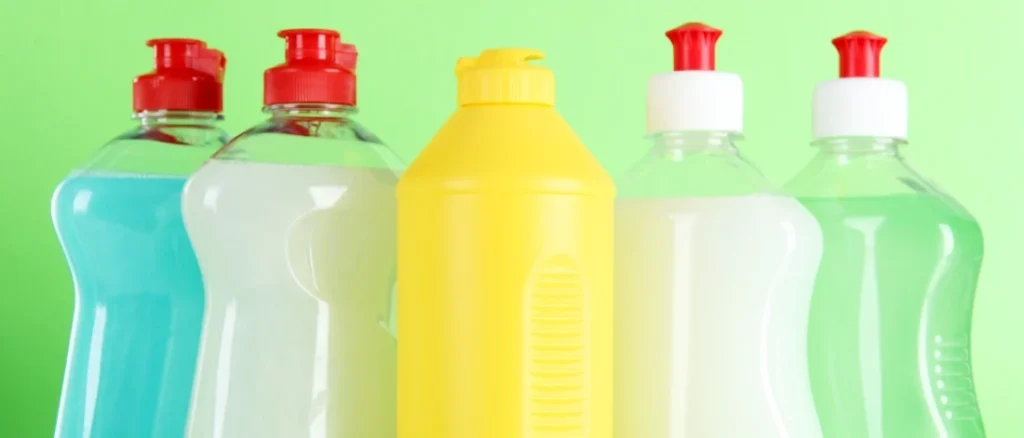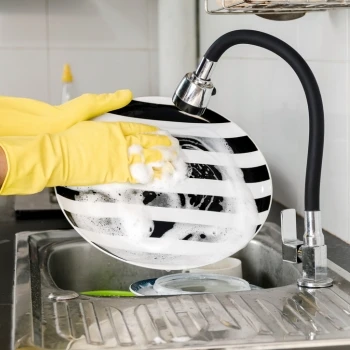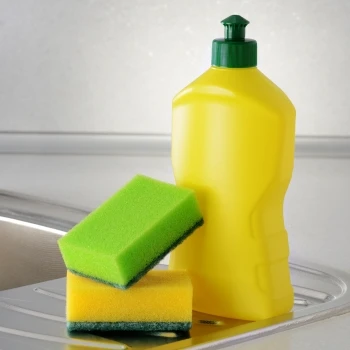
In every kitchen, dishwashing liquid is a staple, but are you using it effectively? The way you use dishwashing liquid can significantly impact your household budget, your time management, and the environment.
This article explores how to maximize the effectiveness of your dishwashing detergent, ensuring sparkling dishes while saving money and simplifying your chores.
Quick Summary
• Dishwashing liquid functions well for cleaning a variety of items including dirty dishes and greasy kitchen appliances.
• Dishwashing liquid can also be used for cleaning floors, washing car wheels, and maintaining outdoor furniture, making it a versatile addition to household cleaning supplies.
• After using regular dish soap, it’s important to thoroughly rinse your hands and apply a moisturizer to replenish skin hydration and restore its protective barrier.
Cleaning Dishes and Utensils

Having the proper tools at your disposal is essential when it comes to cleaning kitchenware.
To get started, assemble a sponge, drying rack, and a few drops of your powerful dish detergent.
Remove any remaining food scraps from dirty dishes and discard excess cooking oil separately to avoid blockages in your drains.
Proceed to organize items within the sink starting with larger pieces such as pots and pans, proceeding down to smaller utensils. This tactic prevents less soiled items from getting re-dirtied by those that are more grimy.
Mix up a cleansing concoction using one teaspoon of concentrated dish liquid per gallon of hot water for effective cleaning action. Moisten your sponge with warm water, squeeze out excess moisture then apply a few drops of dish soap directly onto it until suds form.
Tackle washing duties by addressing silverware initially, subsequently moving on to glassware followed by plates and bowls. Reserve heavily soiled cookware until the end so you don’t smear grime back onto freshly cleaned surfaces.
For stubborn baked-on debris allow these wares an extended soak in straight-up concentrated detergent ranging between half an hour or overnight depending upon the severity level required—30 minutes will often suffice but leave them longer if needed for particularly tenacious remains.
After completing scrubbing tasks, ensure you rinse away leftover food particles from both crockery & clean-up basins alike.
Wrap up this sanitation sequence allowing washed articles time for air-drying. Evaporation plays its part here enabling pristine results without residue marks taking shape post-wash cycle involvement thereby enhancing efficiency parameters concerning dishwasher application whenever employed downstream during routine housekeeping maintenance schedules.
Degreasing Kitchen Appliances

Stovetops and grates in the kitchen can accumulate a heavy buildup of grease and dirt. An effective remedy for this is to employ an ordinary dishwashing soap combined with an agent for cutting through grease.
For thorough cleaning of gas stovetops:
1. Immerse a gentle sponge in warm water blended with a degreasing type of liquid dishwasher detergent.
2. Allow the grates to bathe in soapy water before scrubbing them using this liquid.
3. To simplify this chore, opt for using either nylon scouring pads or brushes.
When dealing with electric stovetops, follow these steps instead.
1. Gently cleanse both coils and control knobs utilizing a sponge dampened by hot sudsy water.
2. Disengage drip pans along with coils from their positions.
3. Treat any stains on drip pans by soaking them first and then applying baking soda as necessary during scrubbing.
Cleaning glass stovetop surfaces requires extra care: add a few drops of your chosen dishwasher detergent onto it, and wait several minutes allowing it time to work its magic before gently wiping clean using non-abrasive sponges so as not to leave scratches while maintaining the pristine condition of your appliance surface.
Cleaning Floors
Dishwashing liquid is an excellent choice for cleaning floors because it cuts through grease and grime without leaving residue, making your floors shine.
1. Prepare the Cleaning Solution: Mix a few drops of dishwashing liquid with a gallon of warm water in a bucket. Ensure the solution has enough soap suds but is not overly soapy.
2. Mop the Floor: Dip a mop into the cleaning solution, wring it out well, and mop the floor in sections. Change the water as it becomes dirty to avoid spreading grime.
3. Rinse if Necessary: For most no-rinse dish soaps, a rinsing step is only needed if the floor is very sticky or the soap used is not intended for floor cleaning.
4. Dry the Floor: After mopping, allow the floor to air dry or go over it with a dry mop to speed up the drying process and prevent water spots.
Cleaning Car Wheels

Dishwashing liquid is effective in removing the tough grime and brake dust that accumulate on car wheels, leaving them spotless and restored.
1. Prepare the Cleaning Mix: Combine a moderate amount of dishwashing liquid in a bucket of warm water to create a frothy solution.
2. Apply the Solution: Dip a soft brush or sponge into the solution and scrub the wheels thoroughly, focusing on the tough spots where brake dust and road grime accumulate.
3. Rinse Thoroughly: Use a hose to spray down the wheels with clean water, ensuring all soap and loosened dirt are washed away.
4. Dry the Wheels: Wipe the wheels with a clean microfiber towel to prevent water spots and to bring out the shine.
Cleaning Outdoor Furniture
To use dishwashing liquid effectively for cleaning outdoor furniture follow these tailored steps
1. Prepare a Cleaning Solution: Mix a few drops of your favorite dishwashing soap with warm water in a bucket. The amount should be enough to create foamy suds without being overly soapy.
2. Use a Soft Brush or Cloth: Dip a soft brush or cloth into the soapy water. Gently scrub the surfaces of the furniture to remove dirt, bird droppings, and other residues.
3. Rinse Thoroughly: Use a garden hose or a bucket of clean water to rinse the furniture. Ensure all soap residue is removed as it can attract more dirt or degrade the material over time.
4. Dry Completely: Wipe down the furniture with a dry towel or let it air dry to prevent water spots and rusting (if metal).
Safety and Precautions

Here’s a detailed look at the safety considerations associated with the use of dishwashing liquids:
- Keep out of reach of children and pets: Ordinary dishwashing soap must be stored in high cabinets or locked storage areas where children and pets cannot access them.
- Avoid extreme temperatures: Store the dish detergent in a cool, dry place to prevent degradation of the product, Proper storage also reduces the risk of the dishwasher’s soap container from bursting under extreme heat.
- Ensure the cap is secure: Always make sure the cap is tightly closed to prevent spills and leaks, which can be a slipping hazard and also wasteful.
- Moisturize: After washing using an ordinary dish liquid, rinse your hands thoroughly and apply a moisturizer to help restore skin hydration and barrier function.
- Avoid ingestion: Keep dishwashing liquids away from food items and ensure that dishes are thoroughly rinsed to remove any soap residues before use.
- Follow instructions: Always use the recommended amount of ordinary dish liquid as specified on the label. Overuse can lead to excessive foaming and slippery conditions.
- Dilution: Properly dilute dishwasher detergents as recommended. This ensures that it is effective without being wasteful or overly concentrated, which could damage materials or irritate the skin.
By following these safety and precautionary measures, you can safely and effectively use dishwashing liquid without risking health or environmental harm.
FAQs
How Much Dishwashing Detergent Should I Use For a Sink Full of Dishes?
The amount of dishwashing detergent needed can vary slightly based on the brand and concentration of the formula, but generally, a small squirt or about one teaspoon of liquid is sufficient for a standard sink full of water.
Can Dishwashing Liquid Cause Skin Irritation, and How Can I Prevent It?
Yes, dishwashing liquid can cause skin irritation, especially for those with sensitive skin. To prevent irritation, wear rubber gloves when washing dishes to avoid direct contact with the soap. Additionally, opt for dishwashing liquids that are formulated for sensitive skin, which are free from dyes, fragrances, and harsher chemicals.
Is it Environmentally Safe to Use Dishwashing Liquid?
While dishwashing liquids are convenient and effective at cleaning, they can contain ingredients that may not be environmentally safe. To minimize environmental impact, choose dishwashing liquids that are biodegradable and free from phosphates and other harsh chemicals.
Did you enjoy this article? See Wynbert’s homepage for more information on how to keep your household pristine clean.
